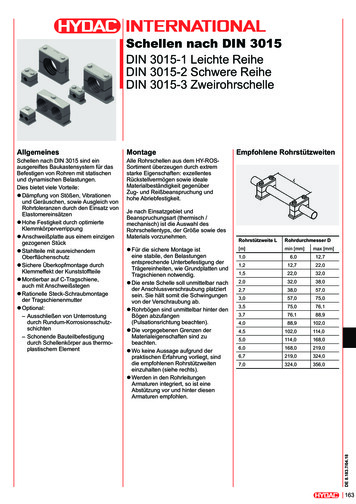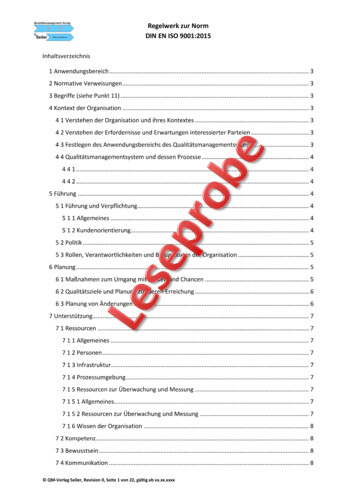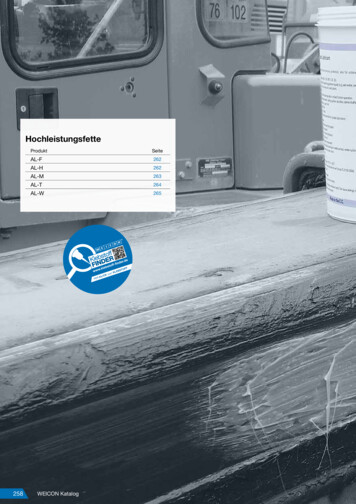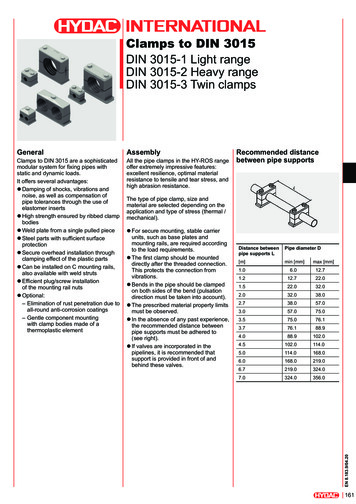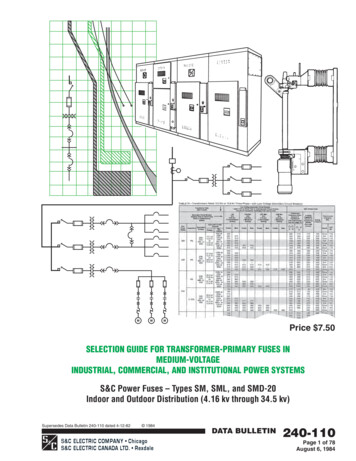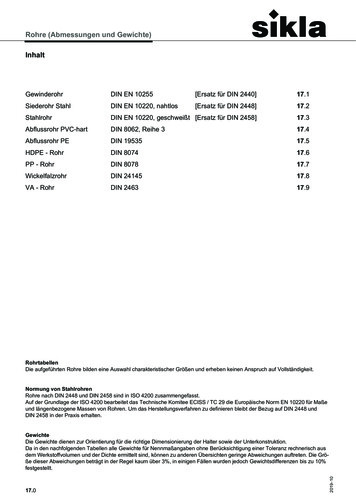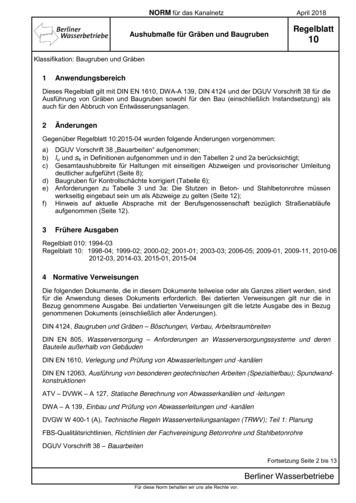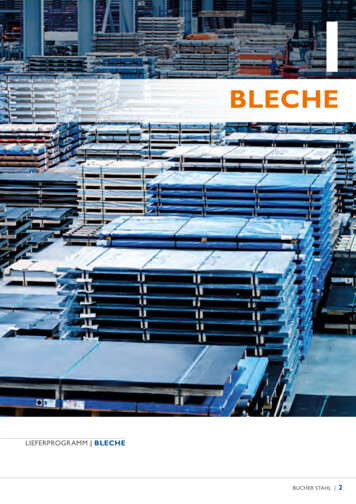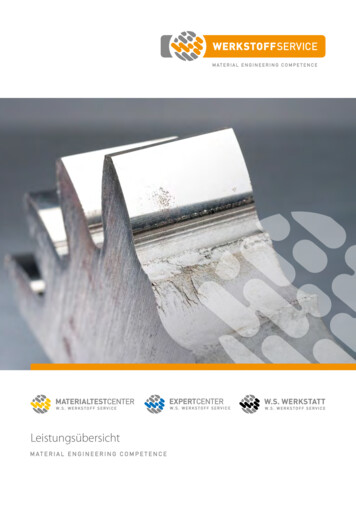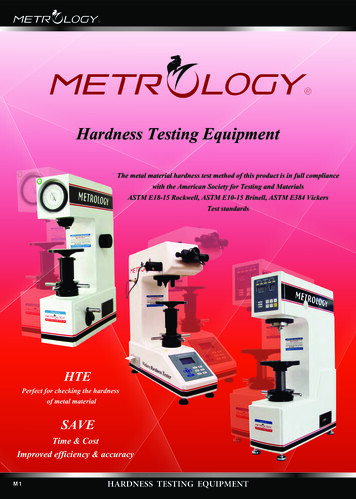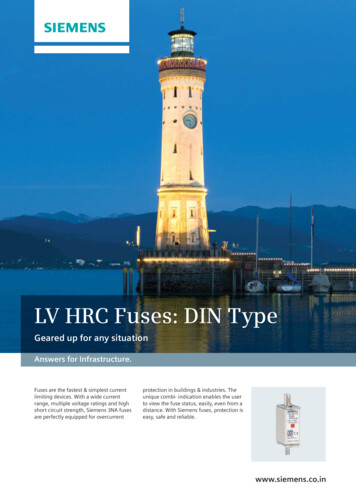
Transcription
sLV HRC Fuses: DIN TypeGeared up for any situationAnswers for Infrastructure.Fuses are the fastest & simplest currentlimiting devices. With a wide currentrange, multiple voltage ratings and highshort circuit strength, Siemens 3NA fusesare perfectly equipped for overcurrentprotection in buildings & industries. Theunique combi- indication enables the userto view the fuse status, easily, even from adistance. With Siemens fuses, protection iseasy, safe and reliable.www.siemens.co.in
HRC FusesIntroductionType 3NA3Short data description : 3NA7 LV HRC FusesStandardsIS 13703 Part 2 Section 1(1993); IEC 60269-2DimensionsIS 13703; IEC 60269-2Operating classgGRated VoltageAC 500V* / DC 440V upto 630A (DC 250V for size 00)AC 690V/DC 440V (DC 250V for size 00)Rated Current Range2A-800A, AC 500V40A-500A, AC 690VRated Breaking CapacityAC 120kA / DC 25kAMounting positionas desired but preferably verticalResistance to climate-30 C to 50 C at 95% relative humidityLV HRC FusesDuring installations, when the HRCFuses are mounted on the fusebases or Switch Disconnector FuseUnits in panels above certainheight, it is very difficult to identifythe status of the fuse link; whetherhealthy or blown. This necessitatesrequirement of additional frontindication.The combination indicator Fuse hastwo indicators as against one usedin conventional fuses. Oneindicator is on top cover platesimilar to conventional fuses andother indicator is at the centre ofthe ceramic body of the fuse link.This helps in clear identificationof status of fuse also from thefront.3NA7 LV HRC Fuses are available in4 different sizes from 2 to 400A.The Size 3 fuses (315A -800A)continue to be with single indicatoron top. The main part of the LVHRC fuse is the fuse element ofhigh-grade copper. The importantfactors for conductivity are theresistance value per meter, thematerial thickness and thedimensional accuracy. Threeimportant criteria in the productionof the fuse elements are: Accurate cutting and punching Precise application of the solderdeposit Accurate and concentricinsertion of the fuse-element inthe fuse body.Where several fuse elements areinvolved, these are fitted exactlyparallel to each other in the fusebody. This ensures adequatecooling of the individual arcs. Theprecision of the parallelarrangement can be verified byobserving the beads of moltenmetal after the fuse has respondedto short circuit. The fuse-elementmust not be too close to the wall ofthe fuse body or otherwise therewill be no protective layer of sand.If the arc were to touch the wall ofthe fuse body, the fuse might burstor blow.The fuse elements of 3NA7 & 3NA3fuses are of operating class gG. Theuse of silver-plated or pure silverfuse-elements is not required forphysical reasons.Oxidation, also called scaling ofcopper, reduces the cross-sectionof the fuse-element. This occursonly at a temperature of approx.350 C. In the time/current rangewithin which a fuse operates,however, only temperatures of180 C to 240 C are attained. Hencesafe tripping is ensured with thisfuse element.Advantages High quality of fuse Less stresses to downstreamequipments during short circuitdue to lower let through current Low power losses resulting inhigh economy and minimalheating. Safe and reliable breakingcapacity from the smallestoverload upto the largest shortcircuit current. Finely graded selectivity level forthe optimum use of cable crosssections High resistance to ageing* 400A (Size II) and 800A, are rated at 415V AC2 Constant characteristics evenunder different temperatureconditions
ApplicationsFuses are primarily used for theprotection of cables andconductors against overload andshort-circuit currents, and are alsosuitable for the protection ofequipment. Some of the importantapplications are: Use in radial and ring networkswith high selectivity For back-up protection of MCBs For protection of motor circuitsin which operational short-termoverloads and short-circuitsoccur Short circuit protection forswitching devices such ascontactors and circuit-breakersThe field of application for fusesinclude industrial installations,power supply utilities, equipmentmanufacturers, switchboards andcontrol panels.SelectivityIn an installation, as a rule, severalfuses are connected in series.Selectivity ensures that in anemergency, only the faulty circuitis disconnected, and not the entireoperation. Siemens fuses withoperating class gG for a ratedvoltage up to 230V are mutuallyselective in the ratio 1:1.25. This isdue to the much lower tolerancerange, 5% of the time/currentcharacteristics curve. The standardrequires a ratio limit of 1:1.6,which our fuses clearly exceed.The cable sizes due to the smallerrated currents can also bereduced.Breaking capacityThe fuses distinguish themselveswith their high rated breakingcapacity of alteast 120kA which isachieved through: Fuse element design and themanufacturing process Precise positioning of fuseelement inside the fuse body Chemical purity, grain size anddensity of the quartz sand Resistance to pressure andtemperature change on theceramic fuse bodyThe basic requirements and circuitdata for the testing, i.e. voltage,load factor, switching angle etc. aredetailed in the international(IEC 60269) standards and Indianstandard IS 13703.Co-ordination for cable and lineprotectionCurrent limitation“Disconnection with l2 1.45 x lNfor the conventional continuoustest under the particular testrequirements according to thenamed supplementary part ofstandard IEC 60269”.Along with a reliable rated breakingcapacity, the let through current offuse links can also have asignificant influence on theeconomy of an installation.During the interruption of a shortciruit by a fuse, the short-circuitcurrent also flows through theupstream fuses. The short-circuitcurrent is limited by the networkimpedance.By the simultaneous melting of allnarrow parts of the fuse element,partial electrical arcs assure quickbreaking with greater currentlimitation. The current limitationis therefore, influencedsubstantially by the quality ofmanufacturing.This strong current limitingproperty of 3NA7 protects thesystem for excessive loads.Co-ordination for cable and lineprotectionTo ensure co-ordination of fuseswith respect to cable and lineprotection during overload,according to DIN 0100 part 430,the following conditions apply:(1) lB lN lz (Nominal currentrange)(2) l2 1.45 x lN (Tripping range)lB : Operating current of the circuitlN : Nominal current of selectedprotective devicelz : Permissible current loadingcapacity at given operatingconditions for the cable or lineSiemens fuse links of the operatingclass gG completely conform to thesupplementary part of the standardIEC 60269, the condition being:A direct co-ordination is thereforepossible.Rated watt lossThe economy of a fuse dependsconsiderably on the rated watt loss.This should be kept as low aspossible by minimal self-heating.Siemens fuses, considering theirhigh breaking capacity, have ratedpower losses kept as low aspossible.These values lie far below the limitsspecified in the standards. Thatmeans minimal heating, reliablebreaking capacity and higheconomy.Load carrying capacity at higherambient temperaturesTesting according to IEC 60269According to IEC 60269, the shapeof the time / current characteristicof LV HRC fuse links is referred toan ambient temperature of 20 C 5% C. When being used at ahigher ambient temperature (seediagram), a lower load carryingcapacity should be anticipated. Forexample, at an ambienttemperature of 50 C, a LV HRC fuselink should be loaded with only90% of the rated current. Theshort-circuit behaviour is notaffected by a high ambienttemperature.l2 : Tripping current of theprotective device underdetermined conditions (largetest current)The factor 1.45 is an internationallyaccepted agreement betweenutilisation and level of protectionfor a conductor, when consideringthe disconnection limits and thepossible protective device (e.g.fuses).3
Selection & Ordering DataLV HRC fuses : 500V ACLV HRC fuse links According to IEC 60269/IS 13703 Rated voltage (AC): 500V * Rated voltage (DC): 440V, upto 630A (250V for size 000/00) Utilization Category gG Rated breaking capacity: 120kA (AC), 25kA (DC)SizeRatingOrderNo.A000246103NA7 802-0RC3NA7 804-0RC3NA7 801-0RC3NA7 803-0RC0.125000162025323NA7 805-0RC3NA7 807-0RC3NA7 810-0RC3NA7 812-0RC0.1250004050633NA7 817-0RC3NA7 820-0RC3NA7 822-0RC0.125000801003NA7 824-0RC3NA7 830-0RC0.125001251603NA7 832-0RC3NA7 836-0RC0.19015063801001251603NA7 120-0RC3NA7 122-0RC3NA7 124-0RC3NA7 130-0RC3NA7 132-0RC3NA7 136-0RC0.27012002242503NA7 140-0RC3NA7 142-0RC3NA7 144-0RC0.45022002503NA7 240-0RC3NA7 244-0RC0.4752315*4003NA7 252-0RC3NA7 260-0RC0.6703315400500630*8003NA3 352-0RC3NA3 360-0RC3NA3 365-0RC3NA3 372-0RC3NA3 375-4RC1.040* 400A (Size II) and 800A, are rated at 415V AC4Weightper unitkg
Selection & Ordering DataLV HRC fuses : 690V ACLV HRC fuse links According to IEC 60269/IS 13703 Rated voltage (AC): 690V Rated voltage (DC): 440V, (250V for size 00) Utilization Category gG Rated short circuit breaking capacity: 120kA (AC), 25kA (DC)SizeRatingOrderNo.Weightper unitkg0002461016202532353NA7 802-63NA7 804-63NA7 801-63NA7 803-63NA7 805-63NA7 807-63NA7 810-63NA7 812-63NA7 00405063801003NA7 817-6RC3NA7 820-6RC3NA7 822-6RC3NA7 824-6RC3NA7 830-6RC0.19011251602003NA7 132-6RC3NA7 136-6RC3NA7 140-6RC0.2700.2700.45022503153NA7 244-6RC3NA7 252-6RC0.67034004255003NA3 360-6RC3NA3 362-6RC3NA3 365-6RC1.040A5
Selection & Ordering DataSelection& FusesOrdering DataLow-VoltageLV HRC Fuse BasesFuse bases are available in four different ratings corresponding to different sizes of fuse links. They consist of aninsulated base on which lyra contacts are fixed. Fuse links can be removed under live conditions. The fuse basescan be supplied either with screw terminals or plug in terminal connection.The fuse bases are manufactured in accordance with IEC 269 & IS 13703Rated voltage : AC 690V/DC 440VSpecial Characteristics : Low contact resistance due to silver plated lyra contacts Easy handling due to special shape of lyra contacts Constant contact pressure ensures reliable current conductionConductor- cross sectionupto mm2OrderNo.Weightper unitkgWith screw in connection953NH3 0300.145With plug-in connection6 to 703NH3 0320.1451503NH3 2300.3903003NH3 3300.420Single poleWith screw in connection2x40x53NH3 4300.680 Size 3Rated current 800ASingle poleWith screw in connection2x40x53NH3 430-4RC0.720 Size 00Rated current 160A(Suitable for fuselink ofsize 000/00)Single pole Size 1Rated current 250ASingle poleWith screw in connection Size 2Rated current 400ASingle poleWith screw in connection Size 3Rated current 630A6
Selection & Ordering DataSelection& FusesOrdering DataLow-VoltageIsolating LinksTogether with fuse bases, these isolating links can effectively be used to serve as removable links in feedersinstead of isolators. These are made of silver plated copper alloy in one piece and are similar in construction tothe ribbed contact knife of the fuse link.RatingOrder No.(Nos.)Weightper unit (Kg)1603NG1 0000.0752503NG1 2500.1754003NG1 3000.2606303NG1 4000.280Fuse PullersFuse puller with special insulated handle makes it possible to change fuses even under live conditions (on load).A mechanical lock provided on the fuse puller prevents the fuse link from drapping out the puller. The fuse linkcan be released by merely pressing the push button provided on a fuse puller.Fuse PullerOrder No.UnitWeightper unit (Kg)3NX1 0100.2053NX1 0110.5603NX1 0140.4803NX1 0113NX1 010Fuse PullerType 3NX1 010, 3NX1 011, 3NX1 014suitable for all sizes of fuse linksand isolating links.3NX1 0143NX1 Signal Detector LinkNEW3NX1 signal detector links are used for the remote indication of the fuse status (whether fuse has blown or not).These links are to be used with fuses having non-insulated grip lugs.MLFBDescriptionFuse SizeWeightper unit (Kg)3NX1021 Rated voltage upto 690V AC/600V DC Contact: Microswitch 250V AC, 6A000-40.0363NX1022*3NA1023* Response voltage 9V AC, 2.5A Response voltage 2V; 7A000-40.0150.0153NX1024 Rated voltage upto 690V AC/600V DC Contact: Microswitch 230V AC, 6A000-20.010* To be used with 3NX10217
CharacteristicCharacteristicCurvesCurvesLV HRC Fuse LinksTime-current characteristic chartRange3NA7 8Size000/00Operating classgGRated current2 - 160APre-arcing time (sec)Rated voltageAC 500V / DC 250VEffective short circuit current (A) Peak short circuitcurrent withmaximum DCcomponent Peak short circuitcurrent without DCcomponentMaximum Let Through Current (A)Peak let-through current chartEffective short circuit current (A)8
CharacteristicCharacteristicCurvesCurvesLV HRC Fuse LinksTime-current characteristic chartRange3NA7 1Size1Operating classgGRated current50 - 250APre-arcing time (sec)Rated voltageAC 500V / DC 440VEffective short circuit current (A) Peak short circuitcurrent withmaximum DCcomponent Peak short circuitcurrent without DCcomponentMaximum Let Through Current (A)Peak let-through current chartEffective short circuit current (A)9
CharacteristicCharacteristicCurvesCurvesLV HRC Fuse LinksTime-current characteristic chartRange3NA7 2Size2Operating classgGRated current315 - 400APre-arcing time (sec)Rated voltageAC 500V* / DC 440V* 400A rated at 415V ACEffective short circuit current (A) Peak short circuitcurrent withmaximum DCcomponent Peak short circuitcurrent without DCcomponentMaximum Let Through Current (A)Peak let-through current chartEffective short circuit current (A)10
CharacteristicCharacteristicCurvesCurvesLV HRC Fuse LinksTime-current characteristic chartRange3NA3 3Size3Operating classgGRated current315 - 800APre-arcing time (sec)Rated voltageAC 500V* / DC440V* 800A rated at 415V ACEffective short circuit current (A) Peak short circuitcurrent withmaximum DCcomponent Peak short circuitcurrent without DCcomponentMaximum Let Through Current (A)Peak let-through current chartEffective short circuit current (A)11
Characteristic CurvesSeriesSizeOperational classRated VoltageRated current:::::3NA7 8.-600gG690V AC/250V DC40. 100ATime / current characteristics curves diagramCurrent limitation diagram Peak short circuit current with maximum DC component Peak short circuit current without DC component12
Characteristic CurvesSeriesSizeOperational classRated VoltageRated current:::::3NA7 1.-61gG690V AC/440V DC125. 200ATime / current characteristics curves diagramCurrent limitation diagram Peak short circuit current with maximum DC component Peak short circuit current without DC component13
Characteristic CurvesSeriesSizeOperational classRated VoltageRated current:::::3NA7 2.-62gG690V AC/440V DC250. 315ATime / current characteristics curves diagramCurrent limitation diagram Peak short circuit current with maximum DC component Peak short circuit current without DC component14
Characteristic CurvesSeriesSizeOperational classRated VoltageRated current:::::3NA3 3.-63gG690V AC/440V DC400. 500ATime / current characteristics curves diagramCurrent limitation diagram Peak short circuit current with maximum DC component Peak short circuit current without DC component15
1t20002A - 100A3NA78.21548045800125A - 160A3NA78.3054804514150A - 160A3NA71.307513750151200A - 250A3NA71.47751375192200A - 250A3NA72.477515158102315A - 400A3NA72.587415159133315A - 800A3NA33.71.27415169.512.83NH3 Fuse Bases163NH3 030 (Size 00)3NH3 032 (Size 00)3NH3 230 (Size 1)3NH3 330 (Size 2)
DimensionsDimensions3NH3 Fuse Bases (Continuation)3NH3 430 (Size 3)Isolating Links 3NG3NG3NG1 0003NG1 250/300/400Typeabcdef3NG1 2501352340563583NG1 300150304866.542.593NG1 400150366077.542.51017
DimensionsDimensions3NX Insulated-handle fuse pullers3NX1 0103NX1 01118
Notes19
Your partnersSales offices:AhmedabadChennaiKolkataNagpur3rd Floor, Prerna ArburGirish Cold Drinks Cross Roads, Off G.C.RoadAhmedabad - 380 009: 91 79 40207600Fax: 91 79 40207699Sathak Centre, No.4., Mahatma Gandhi RoadChennai - 600034: 91 44 28334000Fax: 91 44 2833408843, Shanti Palli, Rashbihari Bypass ConnectorEastern Metropolitan BypassKolkata - 700 042: 91 33 2444 9000, 24428641-47Fax: 91 33 2444 9010/135th Floor, Land Mark BuildingWardha Road, Ramdas PethNagpur - 440 010: 91 712 6633000Fax: 91 712 6633111Bengaluru7th Floor, Global Towers, 1057, Avinash RoadCoimbatore - 641 018: 91 422 4336300Fax: 91 422 4336310LucknowNew Delhi28/45, Ashok Marg, Opp. Indira BhawanLucknow - 226001: 91 522 4031022, 4031000Fax: 91 522 40310194A, Ring Road, I.P.Estate, Box.No.7036New Delhi - 110 002: 91 11 2345 5000-09Fax: 91 11 429950305-9-19, 4th & 5th Floor, Laxmi Narasinh EstateOpp. Secretariat Road, SaifabadHyderabad - 500 004: 91 40 2348 2500Fax: 91 40 23243145MumbaiPune8th Floor, R&D Technology CentreThane Belapur Road, Airoli NodeNavi Mumbai - 400 708: 91 22 3326 5005-6Fax: 91 22 3326 5867Tower B/701-705, ICC Trade Tower403A, Senapati Bapat RoadPune - 411016: 91 20 2570 6000Fax: 91 20 2570 6060AurangabadDurgapurKolhapurRourkelaA9, Yogeshwari Vrundavan, Nr. Malhar ChowkGarkheda Parisar, Prem NagarAurangabad - 431210, MaharashtraMobile: 91 9766316446E-mail: santosh.rajhans@siemens.com14, Dinabandhu Mitra PathNear Kavi Guru Middle StopSAIL Co-Operative Area, City CentreDurgapur - 713216Mobile: 91 9874343052E-mail: rana.mitra@siemens.comFlat No.101, Shrushti Mahabharat ApartmentMahavir Garden To Mahavir College RoadNagala ParkKolhapur - 416003: 91 231 2663330Mobile: 91 9881465421E-mail: sachin.chavan@siemens.comHIG - B/207, Phase - 3, Kalinga Vihar, ChhendRourkela - 769015, OrissaMobile: 91 9438529778E-mail: samir.chintak@siemens.com1st Floor, Jyoti MahalNo. 49, St. Marks RoadBengaluru - 560 001: 91 80 22042000Fax: 91 80 22224131ChandigarhSCO 188/191, 3rd Floor, Sector-17 CChandigarh - 160 017: 91 172 4690300Fax: 91 172 4690399CoimbatoreHyderabadTerritory managers:Baroda3rd Floor, OHM Business ParkOpp.Balaji Hospital, Ellora Park, ShubhanpuraBaroda - 390023: 91 265-669210Mobile: 91 9825506962E-mail: .No. 713, Narvekar Lane, ShahpurBelgaum - 590008, Karnataka: 91 831 2495156Mobile: 91 9740277991E-mail: anand.gawade@siemens.comG-1, Hill View AppartmentNavagraha Path, Chenikuthi Hill SideGuwahati - 781003, AssamMobile: 91 9435346708E-mail: Sourav.Bhattacharya@siemens.comBhilaiHaridwar25/2, Nehru Nagar (West), SBI ColonyBhilai - 490020, ChhattisgarhMobile: 91 7869913404E-mail: prashant.ghate@siemens.com6, Nand Puri, Nr. Aya Nagar Chowk, JwalapurHardwar - 249407, Uttarkhand: 91 1334 251943Mobile: 91 9897070133E-mail: ankur.singh@siemens.comBhopalFlat No. 104, Sagar Home Phase-2Sarvadharma Society, Nayapura RoadBhopal - 462042, Madhya PradeshMobile: 91 9977228084E-mail: prajwal.khapekar@siemens.comBhubaneshwarFlat No. 109, Hara Priya ApartmentVivekanand MargBhuwaneshwar - 751002, OrissaMobile: 91 9937097504E-mail: sumit.sengupta@siemens.comCalicutDoor No. 19/C - 192 CPM HouseNaderi (PO), Koyilandy (via)Calicut - 673326: 91 9645963636E-mail: ragesh.ri@siemens.comCochinG-1, Hill View ApartmentNavagraha Path, Chenikuthi Hill SideGuwahati - 781003, AssamMobile: 91 9864110684E-mail: biplab.datta@siemens.comIndoreFlat No. 102, Panchavati Apart.40 Chandralok Colony, Khajrana RoadIndore - 452001, Madhya PradeshMobile: 91 9926939993E-mail: prashant.joshi@siemens.comJaipur6, Park Street, Opp. Pink City Petrol Pump, M.I.RoadJaipur - 302001, Rajasthan: 91 141 5152108Mobile: 91 9829244313E-mail: gupta.arun@siemens.comJalandharH.No.943, Urban Estate, Phase IJalandar - 144022, Punjab: 91 181 4613929Mobile: 91 9876047929E-mail: sunil.singla@siemens.comJamshedpurLudhianaH.No.92, Lajpat Nagar, Near Bus StandLudhiana - 141002, Punjab: 91 161 2770574Mobile: 91 9815502480E-mail: rohit.jagga@siemens.comLudhianaH.No.95, 1st Floor, Model Gram ExtensionNear Bank of IndiaLudhiana - 141002, PunjabMobile: 91 9888484066E-mail: padam.sharma@siemens.comMaduraiSuratTrichy"Aditya Avenue", Flat No.27, 4th Floor, B-WingNear Chandak Circle, Tidke ColonyNasik - 422001, MaharashtraMobile: 91 9822193204E-mail: kiran.kanhurkar@siemens.comDoor No.106, Grd. Flr., 5th Cross StreetVidyasalai Road, Ganapthy Nagar, Thiruvanai KoilTrichy - 605005: 91 431 4345621Mobile: 91 9840843121E-mail: k.saravanakumar@siemens.comPondicherry"Raghavendra ILLAM", Gnd FloorNo 21, 3rd Cross Street, Anna NagarPondicherry - 605005Mobile: 91 9840143536E-mail: lakshmanan.s@siemens.comRaipurFlat No.103, First Floor, Block-B, Shilp EnclaveNr. IAS Colony, Shankar NagarRaipur - 492007, ChhattisgarhMobile: 91 9425057945E-mail: brajesh.rathor@siemens.comJodhpurK.G.Oxford Business Centre3A, Shreekandath Rd, RavipuramCochin - 682016Mobile: 91 9744511109E-mail: sajeen.s@siemens.com371, Gauri HouseKamala Nehru Nagar, Nr. SBI BankJodhpur - 342008, Rajasthan: 91 291 2760371Mobile: 91 9828327200E-mail: naveen.sahariya@siemens.comRanchiKanpurAbove ICICI Prudential Office, Patel NagarMurdhewa, Distt. SonebhadraRenukoot - 231217, Uttarpradesh: 91 544 254693Mobile: 91 9838007897E-mail: bhav.srivastava@siemens.comSiemens Ltd.Industry SectorBuilding Technologies DivisionLow Voltage Global ComponentsR&D Technology CentreKalwa Works, Thane Belapur Road, Thane - 400 601Fax: 91 22 33265627Email: ustry3/25, Santosh NagarPACB Backside, ChinnathirupathiSalem - 8: 91 427 2401981Mobile: 91 9894617772E-mail: rubengerald.s@siemens.comNashikCochinFlat No.403, Gulmohar Garden Phase IINear Mariampur Hospital, Chain FactoryShastri NagarKanpur - 208005Mobile: 91 8009900939E-mail: shagun.gupta@siemens.comSalemFlat No. 202, D-1, Suryam ResidenceCause Way Road, Opp. Hari DarshanShinganpor-Dabholi Road, KatargamSurat - 395004, GujaratMobile: 91 9925001779E-mail: chandrakant.keshrani@siemens.com823, Udaigiri Vijaya Heritage, Uliyan, KadmaJamshedpur - 831005, Jharkhand: 91 657 6451637Mobile: 91 9934311352E-mail: shaibal.parial@siemens.com32, Dhronpuri, Main Lane, G.M.S.Deharadun - 248001, UttarakhandMobile: 91 8650404404E-mail: shashibhushan.prasad@siemens13/14, Model ColonyNr.Gopinath Mandir, Station RoadRudrapur - 263153, Distt. Udhamsingh NagarUttarkhandMobile: 91 9839813707E-mail: singh.ajay@siemens.com8/12, Ground Flr.Sakhti Vellammal Street, SS colonyMadurai - 625010, Tamil NaduMobile: 91 9894617780E-mail: mahendiran.murugan@siemens.comK.G.Oxford Business Centre3A, Shreekandath Rd, RavipuramCochin - 682016: 91 4028611/22Mobile: 91 9387384848E-mail: aj", Chandanpark SocietyOpp. Gyanganga Vidhyapith, Nr. Raiya CircleRajkot - 360005, GujaratMobile: 91 9825021026E-mail: hiren.raythatha@siemens.comH-1/187, Harmu Housing Colony, HarmuRanchi - 834002, JharkhandMobile: 91 9234610953E-mail: kiran, T.C.No.28/535Krishnakovil Road, KaithamukkuTrivandrum - 695024, KeralaMobile: 91 9895979604E-mail: antony.john@siemens.comUdaipur303, Oasis Park, PP Singhal Marg, AmbavgarhUdaipur - 313001, Rajasthan: 91 294 2430345Mobile: 91 9829039120E-mail: ajit.parashar@siemens.comVapiFlat No.302, Samrajya IV, Royal ResidencyGokul Vihar Township, Charwada RoadVapi - 396195, Gujarat: 91 260 6451156Mobile: 91 9825147957E-mail: sachin.paradkar@siemens.comVijaywada74-32-1, Flat No.304, Tummala ResidencyOpp. Current Office Pandaripuram, Ashok NagarVijayawada - 520007, Andhra Pradesh: 91 866 3060833Mobile: 91 9866463639E-mail: santosh.p@siemens.comVizagFlat No. 401, Door No. 9-19-6Vinayagar South Avenue, CBM CompoundVishakhapatnam - 530003, Andhra Pradesh: 91 891 6462229Mobile: 91 98492 12555E-mail: kvs.prasad@siemens.comOrder No.: 103794117GC-01-005-005(This replaces ET-01-014-004)Customer Care Toll free no.1800 220 987 / 1800 209 0987Email: adscs.india@siemens.comProduct upgradation is a continuous process. Hence, data inthis catalog is subject to change without prior notice. For thelatest information, please get in touch with our Sales Offices.
of the time / current characteristic of LV HRC fuse links is referred to an ambient temperature of 20 C 5% C. When being used at a higher ambient temperature (see diagram), a lower load carrying capacity should be anticipated. For example, at an ambient temperature of 50 C, a LV HRC fuse link should be loaded with only 90% of the rated .
